

Watch: First Methanol Container Ship to Visit The U.S Named At the Port of Los Angeles

Japan to Construct the World’s Largest Coast Guard Cutter Overtaking China’s CCG 5901

India to Commission Its 2nd Nuclear-Powered Submarine, INS Arighat in Visakhapatnam

HD Hyundai Acquires Leading Fuel Cell Company Convion For $80 Million

The Biggest Cruising Sailing Trimaran in the World
The world premier presentation of a giant trimaran, a project by Monegasque company UltraLuxum, was recently done at Monaco Yacht Show (21 to 24 September 2011).
Constructed in carbon fiber and fitted with retractable floats, the UltraLuxum CXL harnesses the very best of 21st-century technology. She is luxurious, inhabitable and ecological. The project is sponsored by the Monaco Yacht Club, involved on behalf of the Albert II Foundation and its Wood Forever program.
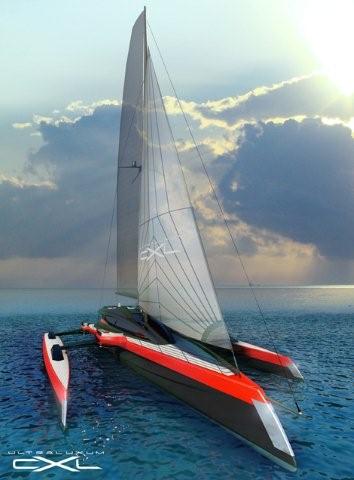
On 23 September 2011, during the Monaco Yacht Show, the UltraLuxum CXL project will be unveiled at the Monaco Yacht Club, the project’s official sponsor. With her 48 meters in length and entirely constructed in carbon fibre body weighing a total of 110 tons, she is the biggest cruising trimaran in the world.
Furthermore, the giant will have a mast measuring 55 meters in height, suitable for approximately 1200m² of total sailing area. This should easily enable to navigate at a speed of between 20 and 25 knots under sail, affording passengers a perfectly comfortable ride.
The engines that are envisaged being diesel-electric will reach very comfortable speeds (approximately 15 knots) whilst consuming 40% less than a monohull of the same size.
Compared with a super yacht of the same length, the space available inside the trimaran is enormous. It can therefore be fitted out more completely for longer stays on board. For example, each of its three cabins has an en suite head.
There is also a spacious dining room, a lounge area, a flat-screen TV, an audio/video system on demand and Wi-Fi, a solarium with Jacuzzi on the fly bridge, and equipment for diving and other nautical activities. Swarovski, one of the project’s official suppliers, will ensure an innovative approach to the interior design, incorporating crystals and unique lighting features.
The furniture inside the yacht will be unique as custom made with some removable elements. Furthermore, the trimaran’s huge garage will house a supercar that is delivered with the boat; the brand of the vehicle will be revealed at the project’s launch.
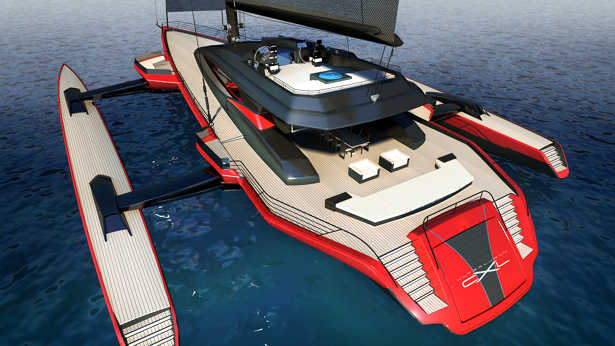
Finally, the trimaran will be constructed in compliance with the requirements of operation Wood Forever, launched by the Albert II Foundation. The wood used will comply with the program’s standards.
The boat’s retractable fl oats constitute the biggest technological challenge of that project. Once tucked in (port configuration), they reduce the width of the yacht from 23 to 11 meters, which is extremely practical when seeking a berth in a port! The space inside each fl oat will be used to fit out spare cabins plus a huge technical area.
Disclaimer : The information contained in this website is for general information purposes only. While we endeavour to keep the information up to date and correct, we make no representations or warranties of any kind, express or implied, about the completeness, accuracy, reliability, suitability or availability with respect to the website or the information, products, services, or related graphics contained on the website for any purpose. Any reliance you place on such information is therefore strictly at your own risk.
In no event will we be liable for any loss or damage including without limitation, indirect or consequential loss or damage, or any loss or damage whatsoever arising from loss of data or profits arising out of, or in connection with, the use of this website.

About Author
Marine Insight News Network is a premier source for up-to-date, comprehensive, and insightful coverage of the maritime industry. Dedicated to offering the latest news, trends, and analyses in shipping, marine technology, regulations, and global maritime affairs, Marine Insight News Network prides itself on delivering accurate, engaging, and relevant information.

Read More Articles By This Author >
Do you have info to share with us ? Suggest a correction
Daily Maritime News, Straight To Your Inbox
Sign Up To Get Daily Newsletters
Join over 60k+ people who read our daily newsletters
By subscribing, you agree to our Privacy Policy and may receive occasional deal communications; you can unsubscribe anytime.

BE THE FIRST TO COMMENT
One comment.
Thanks for this article! I’m Student at Naval Arhitecture and your website realy help me, with many information in our domain of activity. Sorry for my english skills, I try to improve it!
Leave a Reply
Your email address will not be published. Required fields are marked *
Subscribe to Marine Insight Daily Newsletter
" * " indicates required fields
Marine Engineering
Marine Engine Air Compressor Marine Boiler Oily Water Separator Marine Electrical Ship Generator Ship Stabilizer
Nautical Science
Mooring Bridge Watchkeeping Ship Manoeuvring Nautical Charts Anchoring Nautical Equipment Shipboard Guidelines
Explore
Free Maritime eBooks Premium Maritime eBooks Marine Safety Financial Planning Marine Careers Maritime Law Ship Dry Dock
Shipping News Maritime Reports Videos Maritime Piracy Offshore Safety Of Life At Sea (SOLAS) MARPOL
Prout PT 138: The World’s largest sailing trimaran taking shape
- Inspiration
Related News
Popular news this week, popular news this month, latest news.
- Yacht Charter & Superyacht News >
Written by Chelsea Smith
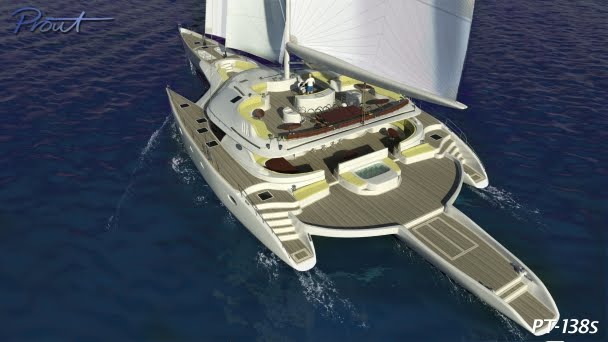
World’s largest sailing trimaran Prout PT 138
Breaking records, Prout has successfully infused all three hulls of its innovative sailing trimaran, the PT-138 , using epoxy resin at the yard in Zhuhai (China). The Prout Trimaran 138’ is designed and constructed as an all-composite shallow draft sailing trimaran with a 46 ft beam with a very small draft of only 1.52 m. The hull and deck are to be constructed utilizing Prout International’s mold and when the Prout PT 138 is launched it will be the largest sailing trimaran in the world.
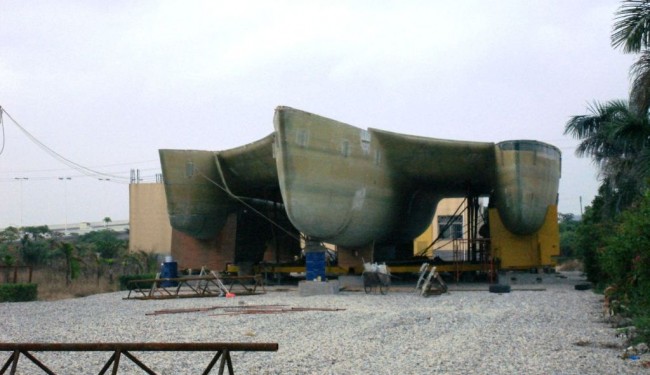
Trimaran Prout PT 138 infused hull
This 138 ft trimaran has been designed to conduct extended offshore passages with her owner and may also be used for luxury yacht charters.
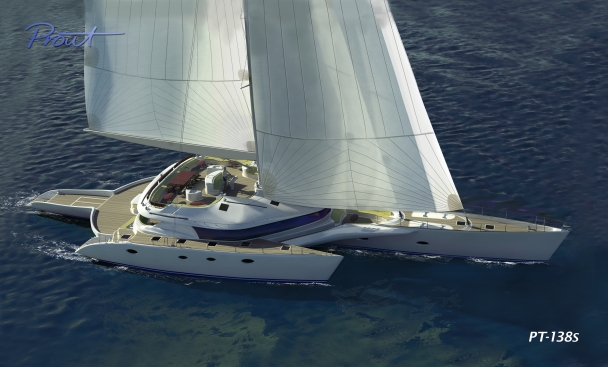
Prout Pt-138s General specifications:
LOA: 138ft Beam: 46ft. Displacement: 32,767kg. Draft: 1.52m. Rigging and Sails: Mast Height: 43m. Mainsail 257m2 Genoa: 259m2 Gennaker: 271m2 Equipment: Water Tank: 3,785 l Fuel Tank: 15,142 l Engine: 625 cv
Please contact CharterWorld - the luxury yacht charter specialist - for more on superyacht news item "Prout PT 138: The World’s largest sailing trimaran taking shape".
- Charity & Fund Raising
- CharterWorld News
- Classic Yachts
- Coronavirus
- Cruise Ship
- Ecological Yachts
- Expedition Yachts
- Expert Broker Advice
- Feature Superyachts
- Interior Design
- Legal & VAT Yacht Issues
- Luxury Catamarans
- Luxury Gulet
- Luxury Phinisi
- Luxury Trimarans
- Luxury Yacht Design
- Luxury Yachts
- Marinas & Harbours
- Marine Ecology
- Marine Electronics
- Marine Equipment
- Mega Yachts
- Modern Yachts
- Motor Yachts
- New Launch Yachts
- New To Charter
- Open Style Sports Yachts
- Private Jets
- Sailing Yachts
- Social Media
- Sports Yachts
- Superyacht Crew
- Superyacht Photographers
- Superyacht Products & Supplies
- Superyacht Refits
- Superyacht Reviews
- Superyachts
- Uncategorized
- Yacht Builders
- Yacht Charter
- Yacht Charter Destinations
- Yacht Charter Picks
- Yacht Charter Specials
- Yacht Delivered to Owner
- Yacht Designers
- Yacht Events & Boat Shows
- Yacht Fashion
- Yacht Industry News
- Yacht Photos
- Yacht Racing
- Yacht Racing & Regattas
- Yacht Safety Equipment
- Yacht Support Vessels
- Yacht Tenders
- Yacht Videos
- Yachting Associations
- Yachting Awards
- Yachting Business
- Yachts For Charter
- Yachts For Sale
Quick Enquiry
Superyacht news:.
Email Your Yachting News to: news @ charterworld.com
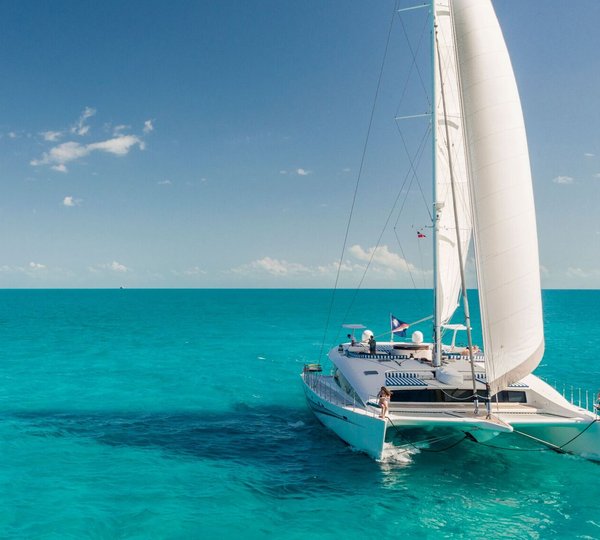
The Caribbean
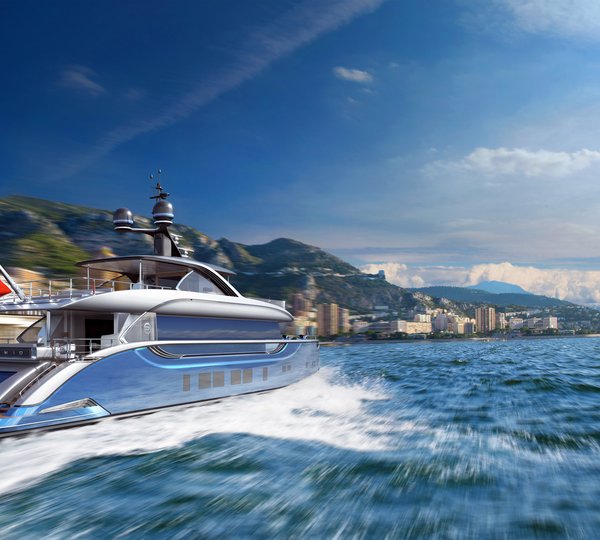
The Mediterranean
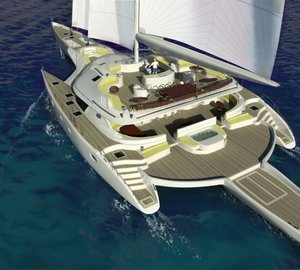
Prout International starts construction of second Prout PT 138: The World’s largest sailing trimaran

Sunreef Yachts to be present at Dubai International Boat Show 2014
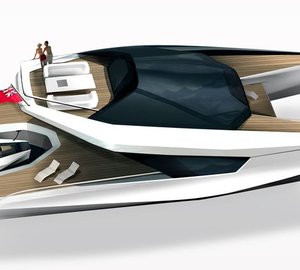
New superyacht projects unveiled by JFA Yachts

Sunreef Yachts to promote its Luxury Catamarans and Superyachts at Monaco Yacht Show 2015
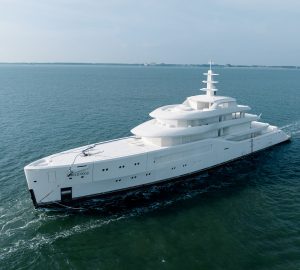
Superyacht AMELS 8002 arrives in the Netherlands for outfitting
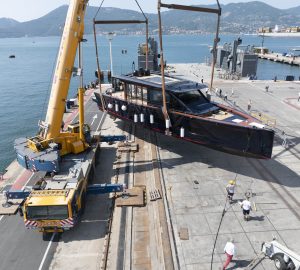
Nautor Swan launches flagship 23m motor yacht SOLLE ONE
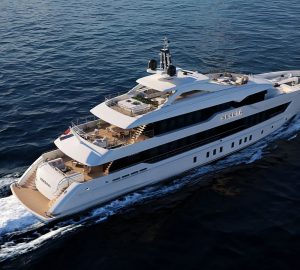
55m superyacht YN20555 is launched by Heesen Yachts and named superyacht SERENA
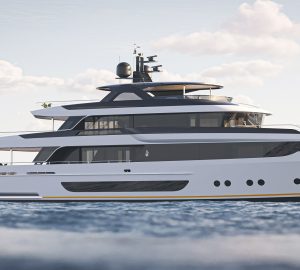
Van der Valk Shipyard announce 35m explorer yacht SAMBA

Aegean Yachts unveil 26m explorer yacht HEKATE
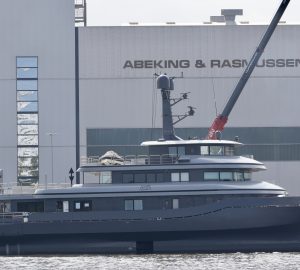
Abeking & Rasmussen’s 41-meter superyacht NURJA relaunched after refit

OCEA delivers 33m motor yacht ARAOK II to her new owner
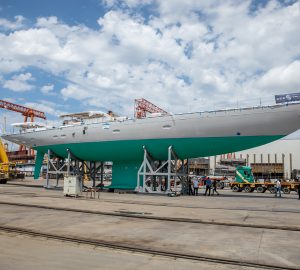
39m sailing yacht LINNEA AURORA launched by SES Yachts
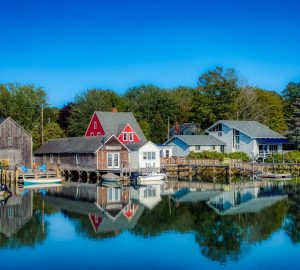
A luxury charter yacht is the perfect way to encounter New England’s fall foliage display
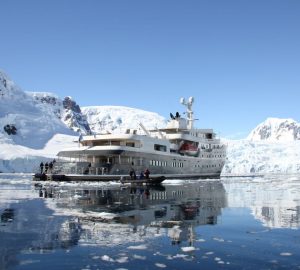
Charter yachts offering citizen science opportunities around the world

A first look at 55m superyacht PROJECT AGNETHA from Heesen Yachts
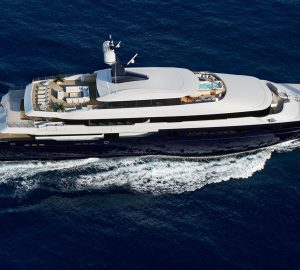
Late summer special offer on board 72m superyacht ARBEMA in the Western Mediterranean
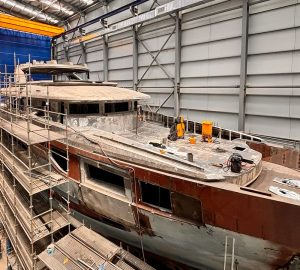
44m superyacht ORION ONE reaches a construction milestone
Yachting Monthly
- Digital edition

Wow, that was fast! Why trimarans are SO much fun to sail – and how to do it
- Theo Stocker
- February 13, 2024
For their size, trimarans can punch well above their weight in speed, cruising potential and fun. Monohull sailor Theo Stocker gets to grips with how to handle one
Humans tend to gravitate into tribes of like-minded enthusiasts, enjoying the encouragement, support and sense of identity, while often looking askance at others; sailors at motorboaters, cruising sailors at racers, monohull sailors at raft, I mean, multihull sailors, and everyone looks askance at jet-skiers.
Large cruising catamarans (40ft now counts as a small one) are a world apart from monohull sailing, but there’s a sub-tribe of sailors dedicated to life on three hulls and builders such as Dragonfly, Corsair, Farrier, and Astus give them plenty of choice.
I’ve been sailing a 22ft (7m) Astus 22.5 this season, with just enough space for a family of four and a minimum of creature comforts. Thanks to her VPLP-designed hulls and 650kg all-up weight, we can sail upwind at 7-plus knots and downwind at over 10 knots with ease, all on a roughly even keel, while the kids play Duplo down below. It can also be beached and is towable behind a car.
Having, it seems, caught the trimaran bug, I wanted to get better at sailing and handling the boat, but my monohull sailing experience and habits were proving something of a hindrance, so we sought advice from some existing trimaran owners, and well as the UK’s top multihull sailors.
Much of the advice will apply to all multihulls , whether two or three-hulled, while other parts are just for small trimarans. I also found that brushing-up some of my rusty dinghy sailing skills helped get my head around what we were trying to do.
To try out our expert tips we went out sailing to see what difference they made. On the day, we got a solid Force 4-5 southwesterly, averaging 16 knots, but fluctuating between 12 and 20 knots true.
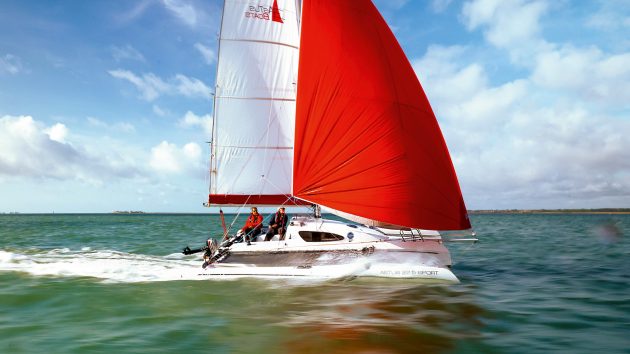
Blasting about on a sporty trimaran is a whole world of fun, but is much calmer than it looks
Trimaran sail trim
One of the biggest differences between a cruising monohull and a multihull is how the mainsail is trimmed. Leech tension on a yacht is often largely controlled by the kicker and the backstay, while the mainsheet sheets the mainsail in and out, predominantly controlling the angle of the boom to the centreline, and there may be a short traveller.
On a mulithull, however, there’s more than enough space for a good, wide traveller. Those who sail on performance monohulls will also be used to this. The sail shape is mainly controlled by the mainsheet, and the traveller then moves the boom towards or away from the centreline.
This is exaggerated on a multihull which has wide shrouds, swept well aft with no backstay, making space for a powerful square-top mainsail with full-length battens. There’s no backstay to bend the mast and flatten what is anyway a pretty rigid mainsail.
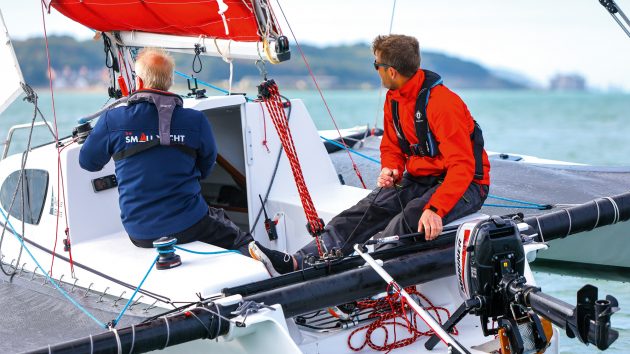
The mainsheet purchase creates enough power to control the leech of the square-top mainsail
Depowering a trimaran
Sailing on a monohull, heel and weatherhelm and eventually a broach give loads of warning that you’re pushing too hard. With straight hulls and little heel, those warning signs don’t really apply to multihulls.
In reality, however, there are a host of warning signals that it’s time to back-off; they’re just a bit different. Even then, there’s still a large safety margin before you get close to danger.
By way of reassurance, with the boat powered up on a beat, Hein, from Boats on Wheels, the boat’s owner, stood on the leeward hull and lent on the shrouds. Even as his feet got wet and the wind gusted at the top of Force 4, the boat didn’t bat an eyelid, thanks to the huge buoyancy of the floats.
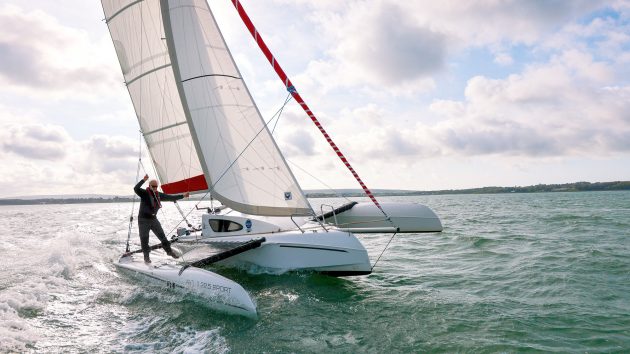
Even with a person on the leeward float the boat was extremely stable
On the water – sail trim
My first inclination was to point the boat as high upwind as possible, pin the sails in and go for height. Doing that resulted in a not-terrible boat speed of 5-6 knots and a good pointing angle.
Free off by a handful of degrees however, and ease the sails just a smidge, and the speed leapt up to 8-9 knots – over 50% more; a huge increase. So, don’t pinch. If you had a decent chartplotter on board, you could find your optimum speed to angle using velocity made good (VMG).
I was also tempted to pinch in the gusts, but it’s better to hold your course and let the speed increase until the main needs easing.
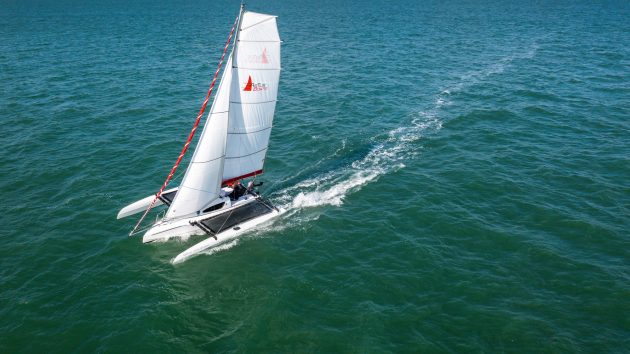
On the wind, it’s time to get the boat fully powered up
If that’s the case, drop the main down the traveller an inch or two or ease some twist into the mainsail and it makes all the difference in the world, but not so far that the top battens fall away and invert – that really isn’t fast. Push too hard and the boat will slow down, largely from the drag of submerging the leeward float and crossbeams. If you’re still overpowered and the main is luffing, it’s time to reef. Downwind is different, but we’ll get onto that later.
After we put a reef in the main, our boat speeds upwind remained largely the same, and the boat was much happier. I came away feeling reassured that even a little trimaran like this would be pretty difficult to capsize, and there were always plenty of warning signs telling me to take my foot off the pedal a little.
Article continues below…

Catamaran sailing skills: Mooring and anchoring a multihull
How do you make an average passage speed of 7 knots, fit in three double cabins and a huge saloon…

Monohull or multihull: which is best for blue water?
As former editor of Yachting World, David Glenn has plenty of experience of both monohull and multihull cruising. Here he…
Tacking and gybing a trimaran
Everyone knows that multihulls don’t tack as well as monohulls. Straight hulls and wide beam don’t lend themselves to turning, especially when coupled with the displacement and fixed keels of big cats. Trimarans are a little easier, with a single central daggerboard to act as a pivot, and one or other of the floats will generally be clear of the water. On the downside, light displacement means that there isn’t much momentum to keep you going through the turn and plenty of windage to stop you.
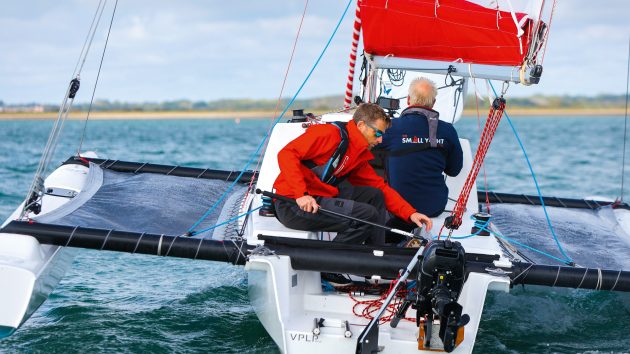
On a trimaran the central daggerboard helps the boat to turn by providing a central pivot point that catamarans lack
Speed is your friend. Build speed up before the tack to give you as much momentum as possible. The helm needs to steer positively into and through the turn, and if necessary, keep the jib backed on the new windward side to help the bow through the wind. Don’t worry about scrubbing speed off, but you don’t want to get stuck in irons.
When it comes to gybing, speed is again key. The turning bit isn’t going to be an issue as you’ll be scooting along, but the faster you’re going, the less load there will be on the sails. The more you slow down, the more the true wind will pile up.
Trimaran sailing skills
Tacks took a bit of practice. It felt plain wrong to jab the tiller across the boat, slamming a big break on in the water but I ended up putting us through the tacks far too slowly, losing a lot of speed. A more aggressive approach worked better. On the Astus, the traveller was between me and the tiller, so the tiller extension needed to be swung around the stern behind the mainsheet onto the new side.
Similarly, old habits of controlling a gybe needed to be modified. With the asymmetric set, we were planing at well over 10 knots, and the ideal is to stay on the plane. Heading dead downwind and centring the main lead to a more violent manoeuvre than flying into the gybe as fast as possible and, as the boom was never that far out thanks to the apparent wind angle, it didn’t need much extra controlling.
Coming up onto the wind after the gybe helped the asymmetric around the front of the jib and to fill on the new side. Stay too deep and it’ll get blanketed by the main. Once we had built up some apparent wind, we could bear away again.
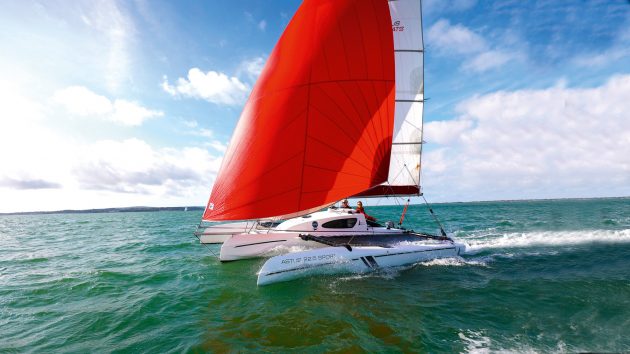
You’ll be on a course deep downwind before you know it, hitting speeds in the double digits
Downwind in a trimaran
Upwind cruising may be fun in a multihull, but bearing away and going with the wind is what it’s all about. Easily-driven hulls, a generous sailplan and light weight mean you can be up and planing, leaving displacement boats wallowing in your wake.
The big difference comes from apparent wind. If you’re in a boat that can do 15 knots downwind in 20 knots of true wind, the resulting wind angles can really mess with your head.
To get going then, says Brian Thompson, ‘Use those leech tell-tales again when sailing downwind and reaching to set the correct twist through the mainsheet, and use the traveller to set the correct angle of the whole sail to the wind.’
As the wind and your speed builds, bear away and trim the main accordingly.
In theory, you shouldn’t need to ease the traveller at all, but you may need to if you want to sail deep downwind. As the gust fades, you’ll find the boat slows down, so you can come back up towards the wind a little to pick up some more breeze, and then bear away as you accelerate again.

Bear away as the boat accelerates. Your course will be something of a slalom as you look to keep a consistent wind angle
This results in something of a ‘slalom’ course, and will also be accentuated if you’re sailing down waves, but that’s all quite normal for apparent wind sailing. Ultimately, you’re looking for a consistent apparent wind angle, even if the resulting wake isn’t straight.
It’s worth remembering that apparent wind reduces the felt effect of the wind, so you need a sailplan to suit the true, not apparent wind speed.
I found that the boat was more sensitive to having a balanced sailplan and trim downwind than upwind, largely because you’ve got almost double the canvas up, with the bowsprit as an extra lever. When weather helm built, I needed to ease the mainsheet to increase twist to depower so that I could bear away. I must admit, getting the boat balanced, sailing fast and light on the helm at 15 knots was something I came away feeling I needed more practice at.
Reviewing the images, I suspect the asymmetric was sheeted in too hard, with too much twist in the main.
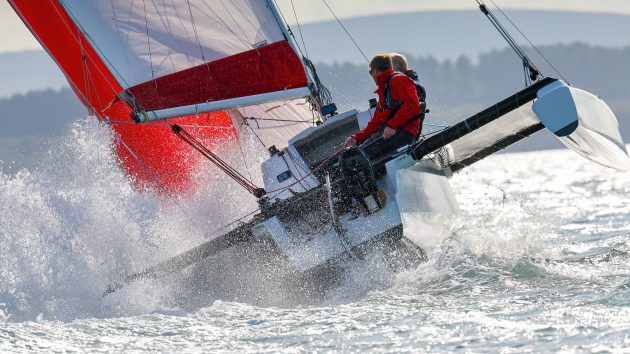
Getting a float fully submerged is when it’s time to back off
On the water
Unfurling the gennaker worked best on a beam reach, giving plenty of airflow over the sail to help it fully unfurl. This was also roughly the fastest point of sail, ideal for getting up some speed for apparent wind sailing. We mostly had the sails set for a close reach, even when we were beyond 120º off the true wind on a broad reach.
It was possible to soak deeper downwind, but lose the apparent wind benefit downwind and our speed dropped off dramatically, prompting us to point a bit higher to find some more speed.
As the boat powered up, it paid to hold a slightly higher angle than I would have done in a monohull for the boat to properly take off and get up into double digit speeds – topping out at 15 knots. Lymington to Cowes would have taken us just half an hour at that speed. It’s easy to give yourself a heck of a beat back!
We were sailing on a pretty flat day, so didn’t have to contend with any waves to speak of. On the recent RTI this is what caused the capsizes of at least two multis, a sobering reminder that you need to sail much more conservatively in lumpier conditions.
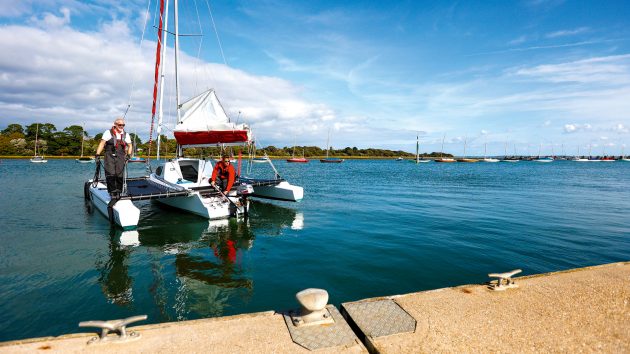
The bows want to point downwind, so a stern-first approach works with rather than against the boat
Coming alongside
A 650kg boat with no draught and plenty of windage feels dreadfully skittish when manoeuvring in confined spaces. Straight hulls with no forgiving curves and fragile-looking sharp bows make berthing tricky. You’ve got a couple of advantages on your side, however. In the Astus, the floats are at pontoon height making stepping off easy.
Whether you have an engine in each hull of a cat, or one in the central hull of a tri, there’s also a lot more leverage to play with to turn the boat and drive her on or off the pontoon. A steerable outboard gives you even more options.
If the boat has a lifting keel or daggerboards, put them down if there’s enough depth to give you a pivot and to resist drifting. Think about getting corners onto the pontoon, rather than putting the boat alongside. On tris, you won’t be able to get to the bow to fend off as it’s too narrow. You can rig a fender up forwards on a line, and two fenders are enough on the flat sides.
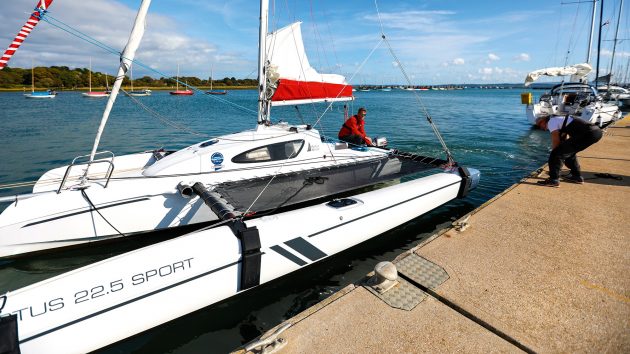
Steering with the outboard towards the pontoon will drive the stern in more; steer away to drive the bow in more
Offshore wind
Coming onto the pontoon with wind blowing off, it worked well coming in stern first. If there’s a tide running, you’ll want to be heading into the tide, so find a spot down wind and down tide to start your approach so you come in at an angle.
On our first attempt we had a bit of tide under us to start with so we came in at a much steeper angle, almost 90º, although this worked out OK in the end.
The crew could then step ashore, taking a line from the stern quarter round a cleat.
Drive forwards against the line and the bow will obediently drive up towards the pontoon, bringing you flat alongside. Getting off was simple, releasing the bowline, and allowing the bow to swing out the before slipping the stern line.
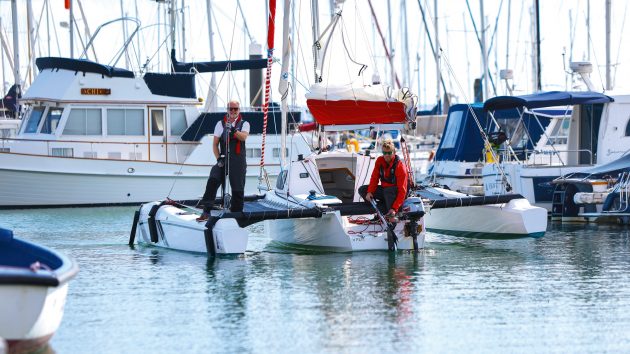
Coming in astern and stopping upwind of the berth meant the bows blew towards the pontoon far to quickly

Onshore wind
Getting onto and off a pontoon with onshore wind proved rather trickier. On our first attempt we came in stern first. The issue was that once we were just upwind of our desired berth and stopped, we lost steerage and the bow immediately blew off with alarming speed towards the pontoon.
Going ahead would only increase the force of the impact, while going astern only increased the bow’s sideways drift. I managed to back out without smashing the bow, but only just, and ended up awkwardly stern to the wind with the bows pointing at the pontoon.
On our second attempt we came in bows first but having aimed at the berth, I had to motor the stern to leeward to stop the bow hitting, making for a rather forceful coming alongside.
On take three, I came in forwards and began ferry gliding towards the berth early, keeping the bows to windward of the stern. Being able to steer with the outboard meant I could go ahead to keep the bow up, and go astern with the engine pulling the stern down toward the pontoon. In this way, it was possible to come in pretty well controlled and parallel to the berth.
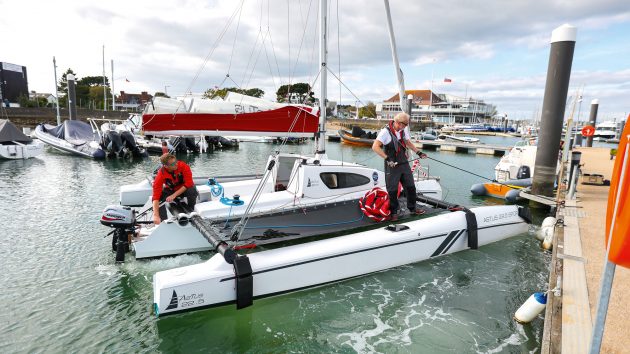
To get out, motoring astern against a bow line pulled the entire boat clear before slipping the line
Leaving was a different proposition all together, as I didn’t want to drag the bow along the pontoon, or to drive hard onto it to spring off. Instead, we rigged a slip-line from the forward cross beam. Going astern against this, and then turning the engine towards the wind, I could pull the stern, and the rest of the boat, out and away from the pontoon.
Keeping power on astern, once we’d reached a decent angle, we slipped the line and went astern, finding steerage way almost at once, with the bow following obediently in our wake with more control than I had anticipated.
Whether the wind is blowing onto, or off the pontoon, you want the engine to be driving or pulling the boat off the pontoon with a line on the corner you are going away from. That way you avoid point-loading fine ends where it’s hard to fender.
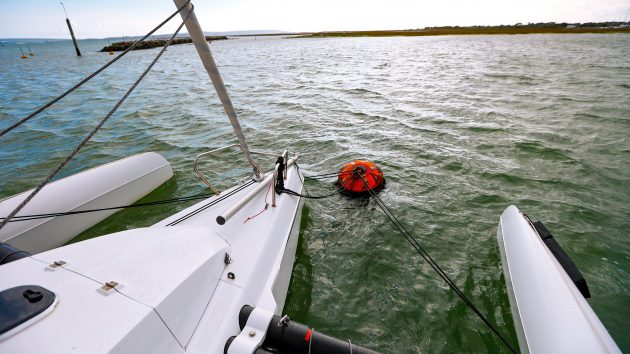
You’ll want a bridle to reduce swinging, but keep the pick up lines on the bow as backup
Anchoring and mooring a trimaran
While mooring a catamaran is complicated by the lack of a central bow, things should be simpler on a trimaran, and they are, mostly. Picking up a mooring buoy from the main hull bow with a low freeboard and dropping the pick-up line onto a cleat is easier even than a monohull.
The bow may be narrow, but for any lines that pass through a ring on the buoy, you still need to take it back to the same cleat to avoid chafe. That should be it, but windage from the two extra bows and the lack of keel mean the boat can dance merrily around the mooring buoy in a breeze.
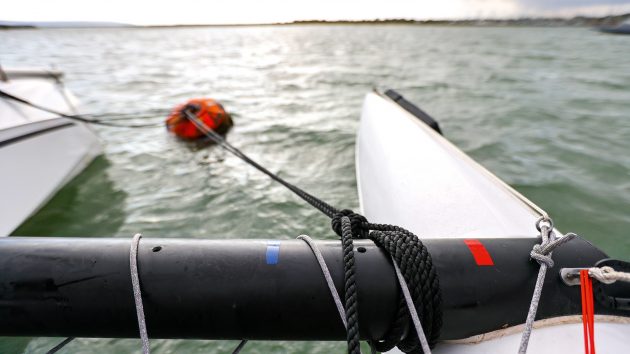
Rig the bridle so the buoy sits to one side to stabilise the boat
In practice, we found that a trimaran benefits from a mooring bridle in the same way that a catamaran does. It can’t be rigged from the floats’ bows, as there are no mooring cleats, so a line passed around the outboard ends of the forward beams gave a pretty good angle, again with long lines passed through the mooring and back to the same side. The main pick-up lines stay as a safety backup.
The other trick is to rig the bridle asymmetrically so that the buoy sits to one side or the other, just enough to not be dead head to wind, making it much more stable in the wind.
On the plus side, the lack of draught or keel means that you’ll nearly always be lying head to wind, so the cockpit remains nice and sheltered whatever the tide’s doing.
We ran out of time on the day to try anchoring, but rigging a bridle, effectively a long snubber to a point on the anchor chain in a similar way wouldn’t be tricky.
If you needed not to swing, or to behave more like deeper boats nearby, hanging a bucket over the stern can help, or there’s always anchoring with a kedge, either out ahead in a V, or in line astern.
Enjoyed reading this?
A subscription to Yachting Monthly magazine costs around 40% less than the cover price .
Print and digital editions are available through Magazines Direct – where you can also find the latest deals .
YM is packed with information to help you get the most from your time on the water.
- Take your seamanship to the next level with tips, advice and skills from our experts
- Impartial in-depth reviews of the latest yachts and equipment
- Cruising guides to help you reach those dream destinations
Follow us on Facebook , Twitter and Instagram.
Free Shipping in the US on Orders $75+

Item added to your cart
The complete list of trimarans.
There is no single trimaran that is best for everyone. Where some prefer luxury cruisers for long trips with family and friends, others might opt for a high performance racing tri for thrilling rides at breakneck speeds. With the recent spike in trimaran popularity, these days there is a perfect tri for every sailor. So to help prospective trimaran owners decide which boat is just right for them, we here at WindRider have put together a comprehensive list of the best trimarans on the market today! Read through for simple at-a-glance trimaran comparisons of boats both big and small, exhilarating and relaxing, and for all price points.
Jump to a specific sailing trimaran: Neel Weta Corsair WindRider Dragonfly Catri Astus Hobie Sea Pearl Farrier Sea Cart Multi 23 Triak SeaRail Warren Lightcraft Diam Radikal Challenger

Known for their award-winning luxury trimarans, NEEL is based in La Rochelle, the capital city of sailing in France. NEEL trimarans are built for fast cruising with an average cruising speed of about 10 knots, and are even configured to facilitate that sustained speed under motor propulsion. The NEEL 45 was notably named Cruising World’s Most Innovative Vessel in 2013, and by all accounts is an easy-to-sail, high performance boat that is just plain fun.
At a glance:
Models: NEEL 45, 65
Length: 45’ – 65’
Cost: $$$$$
Use: Luxury cruiser

A fan favorite, Weta trimarans are fast, stable, and remarkably easy to rig. This single-sailor tri has a capacity of up to three, and the ease with which it can be transported and stored makes this a great, versatile boat for beginners. The Weta was named Sailing World’s 2010 Boat of the Year, and one ride is enough to know why: simply put, the Weta is an absolute ton of fun to sail regardless of skill level.
Models: Weta
Length: 14’5”
Cost: $$ $$$

The high-end Corsair trimaran definitely holds its own in the categories of versatility, performance, and convenience. Boasting a rigging time of 30 minutes from trailer to sailor , the Corsair 42 – whose convenient folding amas makes trailering possible – is a simple option even for single sailors, though cabin space is suitable for two adults. These boats are wicked fast, capable of reaching speeds of 20+ knots, and were made for skilled sailors seeking solid construction and high performance vessels, not for beginners.
Models: Pulse 600, Sprint 750 MKII, Dash 750 MKII, Corsair 28, Cruze 970, Corsair 37, Corsair 42
Length: 19’8” – 37’
Cost: $$$$ $
Use: Sports cruisers

Built for the sailor who wants to maximize the joys of sailing while minimizing any hassle, WindRider trimarans are notoriously fast, very safe, and a blast to sail from start to finish. With several models that can hold between 1 and 6 riders, including adaptive designs to allow participation from sailors of all levels of mobility, there’s something to suit every sailor’s needs. The WindRider 17, an exhilarating ride perfect for families or camper sailors, has been known to reach speeds of up to 20mph. This easy day sailor goes from trailer to sailing in under 30 minutes and is sure to fit in perfectly with whatever adventures you have planned.
Models: WR 16, 17, Tango, Rave V
Length: 10’11” – 18’3”
Cost: $ $$$$
Use: Day sailor

The Danish-built Dragonfly trimarans come in a variety of models ranging from 25’ – 35’, all known for their spry performance, comfortable ride, and ease of use. Every model comes equipped with the unique “SwingWing” feature, a motorized system that can unfold the amas even while the boat is already underway – making it accessible to marinas and slips, and even makes trailering possible. Perfect for those who don’t want to sacrifice their comfort for high performance, the Dragonfly can breeze along at 13 knots while remaining one of the quietest compact cruisers out there.
Models: Dragonfly 25, 28, 32, 35, 1200
Length: 25’ – 39’

Designed for both safe cruising as well as for high speed racing, Catri trimarans will make your day. Especially noteworthy is the Catri 25, a stable yet wildly fast foiling trimaran with accommodations for up to 6 people. With profiles optimized for speeds of 25+ knots when foiling, this is no beginner’s sailboat. The special attention paid to stability in the foil design allows the Catri to be a single sailor vessel, even at foiling speed, with no special physical abilities. Whether you’re taking a small crew for longer rides at shuddering speeds or bringing the whole family along for a shorter, but still thrilling sail, the Catri is truly one of a kind.
Models: Catri 25
Length: 25’
Use: Cruiser/racer

A popular brand of trimaran in Europe, Astus has recently made its way to the US market to the delight of sailors on this side of the pond. Designed to offer maximum pleasure with minimum hassle, all models of Astus trimarans are fast to set up, quick on the water, inherently stable, and always a joy to sail. Their outriggers are mounted on telescopic tubes for easy stowage and towing, and can even be extended and retracted on the water for access to narrow passageways and monohull slips in marinas. With models in all sizes and price points, Astus trimarans are a great option for any sailor.
Models: Astus 16.5, 18.2, 20.2, 22, 24
Cabin: Some models
Length: 16’ – 24’
Use: Sport cruisers
HOBIE ADVENTURE ISLAND

Great for beginners and adventurers alike, the Hobie Mirage Adventure Island series is nothing if not just plain fun. With the option to use as a kayak or as a very basic trimaran, the Hobie is transportable, versatile, unintimidating, lightweight, and wonderfully affordable. The pedal system known as “Mirage Drive” allows a person to pedal the kayak using their legs for an extra kick of movement in slow winds. Amas tuck close to the main hull for docking or car-topping, adding serious ease and convenience to the exhilarating experience of the Hobie.
Models: Hobie Mirage Adventure Island, Mirage Tandem Island
Length: 16’7” – 18’6”
Use: Convertible kayak/trimarans

Best known for its use in camp cruising excursions, the Sea Pearl offers a roomy main hull and particular ability to sail in very shallow waters, making beaching and launching a breeze. The lightweight Sea Pearl trimaran is easy to tow, and the larger-than-expected cabin opens this vessel up for overnight adventures with plenty of storage space. The simple design makes the Sea Pearl notoriously low maintenance, and the ease it takes to rig and sail it add to the overall delight of owning this boat.
Models: Sea Pearl
Length: 21’
Use: Camper cruiser

Quick, lightweight, roomy, and trailerable, Farrier trimarans are made for versatility to fit every sailor’s needs. Different Farrier models are available in plan or kit boat form for those who appreciate building their boat themselves, but of course, also as the full production sail-away boat for the rest of us. Single-handed rigging and launching takes under 10 minutes from start to finish, minimizing hassle and getting you on the water fast. All non-racing Farrier designs use a minimum wind capsize speed of 30 knots or more to ensure safety for all those aboard. Add the roomy cabin and high speed capabilities to the equation and you’ve got a boat that is great fun for everyone.
Models: F-22, 24, 25, 82, 27, 28, 31, 9A, 9AX, 9R, 32, 33, 33R, 33ST, 36, 39, 41, 44R
Length: 23’ – 39’4”
Cost: $$$ $$
Use: Sport cruisers/racers

One of the biggest names in the game, SeaCart is internationally noted for its high performance trimarans that far exceed expectations for a production boat of its size. The SeaCart trimaran performs as brilliantly off the water as it does on with its super-light and efficient harbor folding system, making light work of trailering. Notoriously easy to manage and maintain, the SeaCart 26 One Design is the ultimate day racing trimaran, designed for both course and inshore/coastal distance racing. Absolutely worth the international buzz it has garnered, the SeaCart is a thrill from beginning to end.
Models: SeaCart 26
Length: 26’

A high performance racer class, the Multi 23 is a lightweight, powerful trimaran known for its wicked speed of up to 25 knots. Multi trimarans of both available configurations were designed to give beach cat thrills and speed without any of the stability or seaworthy concerns. Open ocean sailing is no issue for the Multi’s big bows, which do their job to keep her stable. Built for sailors with a need for speed, the Multi makes a perfect weekend boat for racers, especially those with a taste for boat camping.
Models: Multi 23
Length: 23’

Another dual outrigger sailing kayak/canoe design, the Triak trimaran was designed to be effortless and fun, especially for beginners. Paddle the kayak with sails furled, use the foot pedals for an extra kick of momentum, or sail with just the mainsail – the only boat in its class to feature an asymmetrical spinnaker – for exhilarating speeds and a blast on the water. Car-top the Triak anywhere for a quick sail or plan for a week long expedition, but always count on having a great time on this easy little boat.
Models: Triak
Length: 18’
Use: Convertible kayak/trimaran

SeaRail trimarans are known for being affordable, light weight, trailerable trimarans that offer the perfect combination of exciting and relaxing experiences to a wide range of sailors. Whether it’s day sailing with your family, resort or camper sailing, SeaRail trimarans are ideal leisure vessels. Leave the hassle to the other boats – the SeaRail takes you from trailer to sailor in 15 minutes. But don’t let its reputation as a leisure tri fool you: if speed is what you want, rest assured that the SeaRail can deliver that as well.
Models: SeaRail 19
WARREN LIGHTCRAFT

Warren Lightcraft trimarans , another example of a convertible kayak-to-sailboat option, are known for their aesthetically pleasing designs that are also, as the name implies, very light for simple transportation and ease of use. Convert the kayak into a fast, high performance sailboat in just minutes, fly around on the waves all day long, then simply car-top the 68lb Warren for a maximum enjoyment, low-hassle day on the water. Perfect for sailors and paddlers of all skill levels, the Warren Lightcraft is the best of both worlds and an absolute joy to sail.
Models: Warren Lightcraft
Length: 15’6”

Built strictly with racing in mind, the Diam 24 is a light, powerful one-design class trimaran and a notoriously exceptional performer. Boasting blistering speeds of up to 30 knots, Diam trimarans are not intended for beginners. For racers who crave the very best in terms of intense speeds, smooth handling and impeccable performance, the Diam is the red-hot one-design racing tri for you.
Models: Diam 24
Length: 24’

For the sailor who prefers the finer things in life, the Radikal 26 delivers. Perfect for bringing the whole family out for a day on the water, this high performance, trailerable sailing trimaran strikes the most luxurious balance between quicksilver speeds and a smooth, comfortable ride. The Radikal 26 trimaran is as convenient to transport and set up as it is pleasant to sail, with a folding system that minimizes rigging hassle and also makes this a trailerable tri. Built for a fast and comfortable sail rather than a hold-onto-your-seats thrill, one-the-water safety and overall pleasure makes the Radikal 26 what it is.
Models: Radikal 26
Use: Sport cruiser

A solidly-built, single-handed trimaran, the Challenger also doubles as an adaptive design – meaning it is made to accommodate sailors of all levels of physical mobility. Best suited to lakes, the Challenger is a very safe, seaworthy boat for sailors of all ages and experience levels. Add to this the ease of owning, transporting and maintaining the Challenger trimaran and what you get is a simple, fun sailboat perfect both for beginners and those seeking a cheap thrill alike.
Models: Challenger
At a glance comparison:
| Astus 16.5, 18.2, 20.2, 22, 24 | 16’ – 24’ | Sport cruiser | Some models | ||
| Catri 25 | 25’ | Cruiser/racer | Y | ||
| Challenger | - | Day sailor | N | ||
| Pulse 600, Sprint 750 MKII, Dash 750 MKII, Cruze 970, Corsair 28, 37, 42 | 19’8” – 37’ | Sport cruisers | Y | ||
| Diam 24 | 24’ | Racer | N | ||
| Dragonfly 25, 28, 32, 35, 1200 | 25’ – 39’ | Luxury cruiser | Y | ||
| F-22, 24, 25, 82, 27, 28, 31, 9A, 9AX, 9R, 32, 33, 33R, 33ST, 36, 39, 41, 44R | 23’ – 39’ 4” | Sport cruisers/racers | Y | ||
| Mirage Island, Mirage Tandem Island | 16’7” – 18’6” | Convertible kayak/trimarans | N | ||
| Multi 23 | 22’ | Racer | Y | ||
| NEEL 45, 65 | 44’ – 65’ | Luxury cruiser | Y | ||
| Radikal 26 | 26’ | Sport cruiser | Y | ||
| Sea Pearl | 21’ | Camper cruiser | Y | ||
| SeaCart 26 | 26’ | Racer | Y | ||
| SeaRail 19 | 18’ | Day sailor | N | ||
| Triak | 18’ | Convertible kayak/trimaran | N | ||
| Warren Lightcraft | 15’6” | Convertible kayak/trimaran | N | ||
| Weta | 14’5” | Racer | N | ||
| WR 16, 17, Tango, Rave V | 10’11” – 18’3” | Day sailor | N |
Did we miss one? Let us know. Tell us what you sail and what you like about each boat in the comments below.
- Choosing a selection results in a full page refresh.
- Opens in a new window.

6 Best Trailerable Trimarans For Bluewater and Coastal Sailing

As an Amazon Associate, we earn from qualifying purchases. We may also earn commissions if you purchase products from other retailers after clicking on a link from our site.
Having a boat costs a lot of money, even when you are not using it, marina fees, etc. And once it is in the water most sailors never go very far from their “home marina” and sailing will be somewhat restricted. However, what if you could fold your trimaran and put it on a trailer, store it at your house, and go to a new sailing spot the next time?
Here are 6 of the best trailerable trimaran:
- The Dragonfly series
- Corsair Series
- Windrider 17
Choosing the best trailerable trimaran (a multi-hull with three “hulls”) will depend on crucial factors like speed, durability, design, and ease of transportation. This article is here to help you get started with your research and hopefully help you on the way towards your dream boat!
Table of Contents
Cruising Trimarans That Can Be Transported
Cruising boats are made for multiday sailing either on the coast of your favorite sailing area or full-out blue-water ocean crossings. Extended living should be a priority in these designs.
1. The Dragonfly 25 and 28 (Dragon Fly Series)
Dragonfly is in the business of making the “best foldable trimarans on the planet” many would agree with this statement. Dragonfly is known for its commitment to easy trailering and ease of use, shown in designs for the Dragonfly 25 and Dragonfly 28.
The “Swing Wing” system on the linchpins is one of the key features of the dragonfly series. The system’s application makes it possible for the trimaran to narrow its beam as much as 50%.
Attesting to its Scandinavian manufacturing, most parts of the trimaran are made in-house. This guarantees quality and ensures that all used parts are above standard.
You don’t need to look further than the Dragonfly 25. Its centerboard slightly offset to port. Extra space is created in the main hull’s interior with a trunk buried under a settee. Performance-wise, the low drag and narrow hull shape allow the boat to reach blistering speeds.
Dragonfly 28 In Numbers
- Length: 8.75m
- Beam folded: 2.54m
- Max crew: 5-7 people
- Max Speed: 22+knots
Dragonfly 25 In Numbers
- Length: 7.65m
- Beam folded: 2.30m
- Max crew: 4-6 people
- Max Speed: 21+knots
2. Farrier F-22
New Zealand enters the trimaran manufacturing race with this premium sea goer. The vessel comes in two different versions: a performance variation with more horsepower and a full cabin cruising version.
Compared to the dragon series the F-22 has the biggest allowance for space.
The F-22 is known for being one of the easiest trimarans to fold and load.
The sports version of the F-22 has some really good performance to offer. It has an aggressive spirit: you can mount a sail while leaving plenty of space for the boat’s fine entry and flared forward sections. The build quality is also topnotch—a lasting memorial to a principle that Ian Farrier always worked by: excellence.
Farrier F-22 In Numbers
- Length: 7.0m
- Beam folded: 2.5m
- Max crew: 3-5 people
- Max Speed: 20+knots
3. Corsair Series
This boat series has an exciting history. Farrier created it to promote his trailerable tri concept. However, the series is now independent with a top-class vehicle to its name.
The Corsair 760 is listed as providing some of the best performance and safety benefits to sailors.
Building off the spirit of excellence of the founder, the Corsair 760 has created a boat with comfort and racing potential. The boat can be tricky to handle at first, but it will be a breeze once you get the hang of it.
It is also worth noting that the corsair 37 is the largest trailerable trimaran on the market today.
Daysail Trimarans That Can Be Transported
Boats that are made for dayssailing are usually smaller, cheaper and more easily handled. They are perfect for those looking to enjoy a full day on the water in calm weather, but are usually less suitable for multiday events or rough sea sailing.
4. The Astus Models (20ft, 22.5ft, and 24ft)
If you’re looking for something small but still capable of doing day sailing, this 22.5-foot trimaran is for you. Built for speed and maneuverability, the Astus 22.5 has optional foils to optimize speed.
The modern design, coupled with the spacious interior, can fit up to four beds. Accordingly, this trimaran is suited for family outings.
The Astus brand specializes in transportable trimarans, worth noting is that some models need a specific trailer whilst the smaller boats use a standard trailer.
5. Weta 14.5
The 2019 Weta trimaran is a 14.5-foot (4.4-meter) trimaran featuring a carbon frame, centerboard, rudder foil, and rudder shock. The hull is made from fiberglass and foam. The Weta is built for strength and speed based on these lightweight materials.
The 2019 Weta trimaran is easy to sail and is worth considering whether you want to take a quiet sail, race with your friends, or take kids to a sailing lesson. It has a simple design and is easy to set up independently.
The small size makes it more suitable for daysailing in good weather rather than multiday cruising, although more experienced sailors will of course push the limits of this boat.
6. WindRider 17
The 17.4-foot (5.3-meter) WindRider 17 is one of the more versatile trimarans in the market. It packs high performance for a low cost. This trimaran has a light rotating mast to boost performance, and a full-battened mainsail optimizes visibility.
This sailboat is made from rotomolded polyethylene, which is more durable than fiberglass and demands less maintenance.
The WindRider 17 has a comfortable interior and can fit six adults. This is an ideal choice for social sailing for a couple or a family and friends. It’s easy to ride, and a shallow draft allows easy maneuverability.
What’s the Largest Trailerable Trimaran?
The largest trailerable trimaran is the Corsair 37 , this multihull is built for single-handed cruising while still maintaining the ability to comfortably seat 6 people.
The Corsair 37 provides comfort, speed, and safety. It also contains just enough space to accommodate amenities like a propane stove, a sink, and other equipment.
The vessel is designed to be a performance cruiser. It features an aluminum rotating wing mast, carbon fiber bowsprit, and premium deck hardware. The corsair can still cut through the water with ease despite its size, putting the wind in your sails.
What Is a Catamaran?
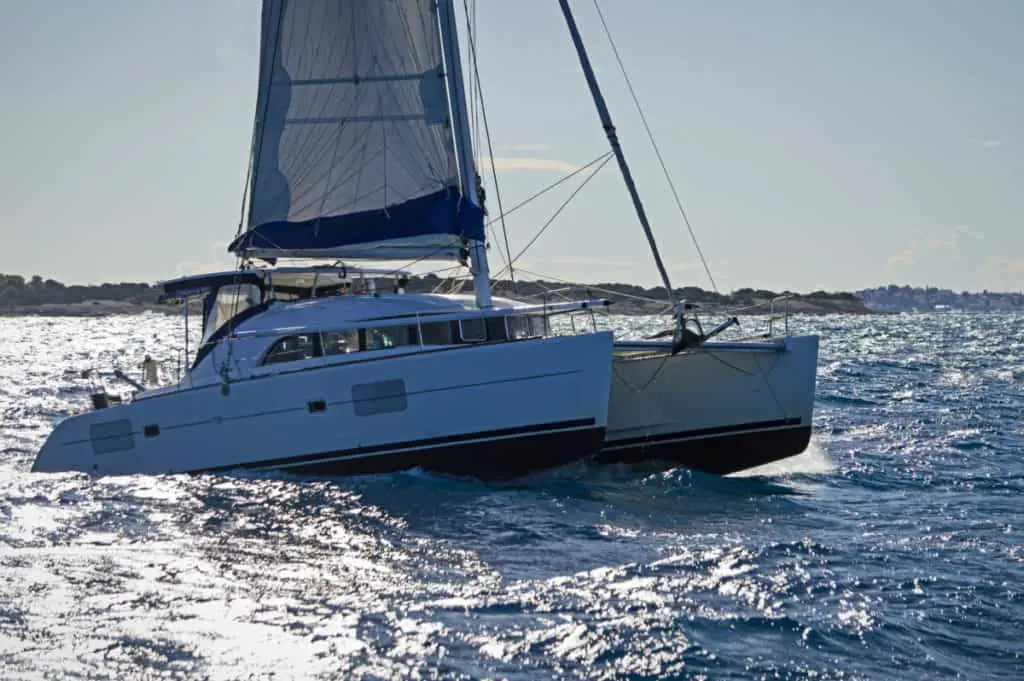
A catamaran is a boat with two hulls (a trimaran has three) connected by a bridge deck. Catamarans usually offer more space than both monohulls and trimarans of the same length. The catamaran is usually somewhat slower than a trimaran but faster than a monohull. They are usually made of fiberglass or carbon fiber.
Catamarans come in all shapes and sizes. You can find straightforward sailing catamarans, perfect for those who are only starting their sailing journey. Larger sailing catamarans have become extremely popular for long-distance sailing.
There are also power catamarans, they have huge diesel-powered engines (sometimes electric) and no sails. Also called “power cats”, these boats can reach 30+kts.
Can a Trimaran Be Trailerable?
As discussed above, some trimarans are possible to put on a trailer and move to another sailing area or to be stored at home. This is usually not possible with catamarans but is sometimes possible with the trimarans that are fitted with foldable amas (the two outer “floats” or “hulls”).
Some trimarans can be trailerable, this is mainly due to the ability to drastically decrease the vessels beam, sometimes as much as 50%. This allows the trailer plus trimaran to be below the legal requirements of the road.
Final Thoughts
It has proven difficult to beat the trimaran in terms of speed. Through the ages, this type of vessel has proven to be immensely enjoyable in all kinds of sailing activities. These can range from sea adventures to waterborne relaxation in your free time.
Trimarans come in various types, foldable, for cruising or racing, etc. However, there is a common factor: many of the small ones are trailerable. This makes them easier to move than most other types of boats.
Owner of CatamaranFreedom.com. A minimalist that has lived in a caravan in Sweden, 35ft Monohull in the Bahamas, and right now in his self-built Van. He just started the next adventure, to circumnavigate the world on a Catamaran!
Leave a Reply Cancel reply
Your email address will not be published. Required fields are marked *
Save my name and email in this browser for the next time I comment.
Recent Posts
Must-Have Boat Gear for Catamaran Sailors!
Sailing is probably the most gear-intensive activity I've ever done; there are so many decisions to be made about what gear to buy now, for tomorrow, and what to definitely never buy. The gear on...
What Kind of Boat Is The Best Liveaboard? Trawler, Monohull, or ...?
Living in a boat can be a thrilling, once-in-a-lifetime experience; however, knowing how to choose the right vessel to sustain the lifestyle you want to achieve can be crucial in making the most out...
- BOAT OF THE YEAR
- Newsletters
- Sailboat Reviews
- Boating Safety
- Sails and Rigging
- Maintenance
- Sailing Totem
- Sailor & Galley
- Living Aboard
- Destinations
- Gear & Electronics
- Charter Resources
- Ultimate Boat Giveaway

2024 Boat of the Year: Best Performance Trimaran
- By Herb McCormick
- December 20, 2023
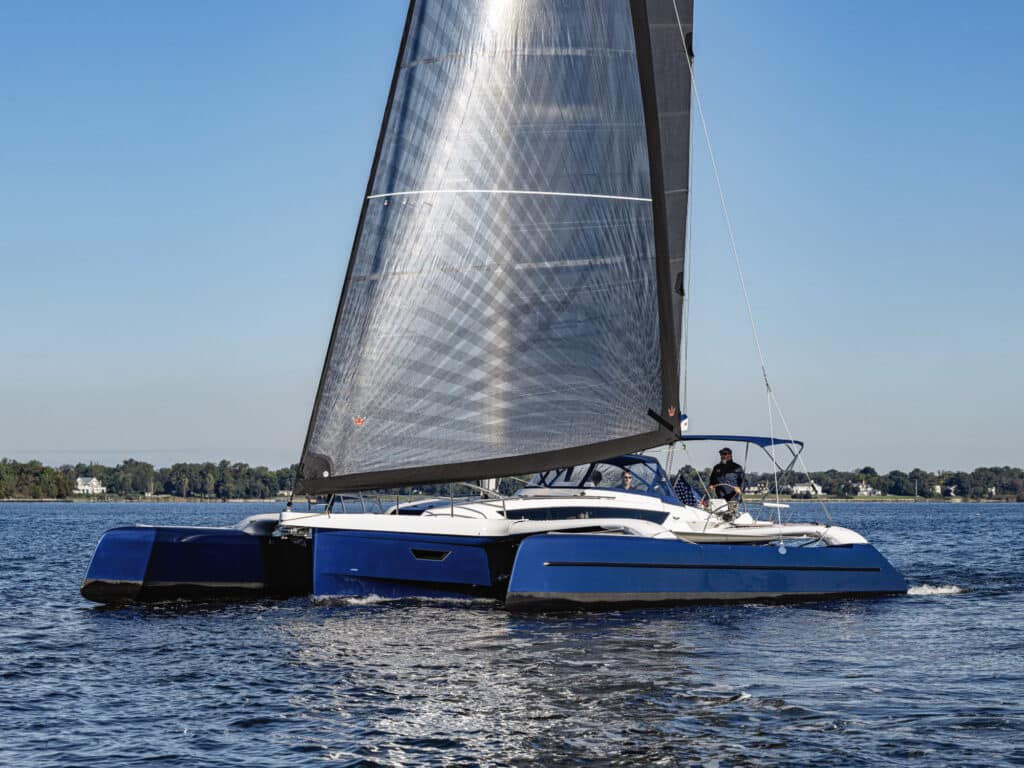
For the first time ever in the 29-year history of Boat of the Year , we’re introducing a new class to the proceedings: Performance Trimarans. To make things spicier, the two nominees not only shared the same length overall of 40 feet, but they also came in at the near-identical price point of around $800,000 for the base boat.
Beyond those two parameters, however, the different approaches from these disparate brands were interesting and exciting. Cruising trimarans, though rare, are nothing new; the well-established Neel line of French-built trimarans has enjoyed plenty of success in previous BOTY contests. With that said, the judging panel was champing at the bit to put these fresh three-hull whizzes through their paces. And once under sail, we were definitely not disappointed.
Winner: Dragonfly 40
Let’s cut right to the chase: The Dragonfly 40 had judge Tim Murphy swooning straight from hello: “This is an exquisite yacht in every detail. When you step aboard, the new-boat smell was not of styrene but of a wood shop. Built in Denmark by the Quorning family (designer and builder Jens Quorning took us on the test sail), it’s just a beautiful boat to look at from across the water. The wheel steering—no tiller here—was butter-smooth. Thanks to the boat’s extremely fine hulls, on our test sail we hardly felt any jerks or deceleration as we passed through several Severn River boat wakes. There were AGM batteries on this boat, but a lithium-battery system is an option. The kick-up centerboard and rudder are ingenious: Quorning as much as invited us to ground the boat on a shoal. From barber haulers to boom preventers, it’s full of great sailing details.”
Judge Mark Pillsbury was equally impressed: “As we finished up our all-too-brief sea trial aboard the Dragonfly 40, I scribbled ‘Top shelf!!!’ in my notebook. We had the benefit of sailing the boat with its thoroughly detail-oriented builder, who pointed to the seemingly endless features he’d employed to make this maybe the most memorable sailing boat of the year. At one point, I looked down at the GPS speed-over-ground number, which read 6 knots, then glanced at the true wind gauge: 5.2! Faster than the wind! The interior of the Dragonfly was elegant, with the furniture rendered in elm—not a wood we often see. But most impressive was the walk-in aft cabin instead of the crawl-in bunk often found in the narrow confines of a tri’s slender center hull.”
Judge Herb McCormick was as astonished as his colleagues: “There isn’t a thing on the Dragonfly that Quorning hasn’t thought long and hard about, and then executed to a stellar degree. Take that centerboard arrangement, which is built into the central dining table and is integrated so well into the interior that it’s a functional piece of furniture as well as a foolproof cruising solution. What else can we say? It’s a magnificent freaking boat.”
Runner-up: Rapido Trimarans 40
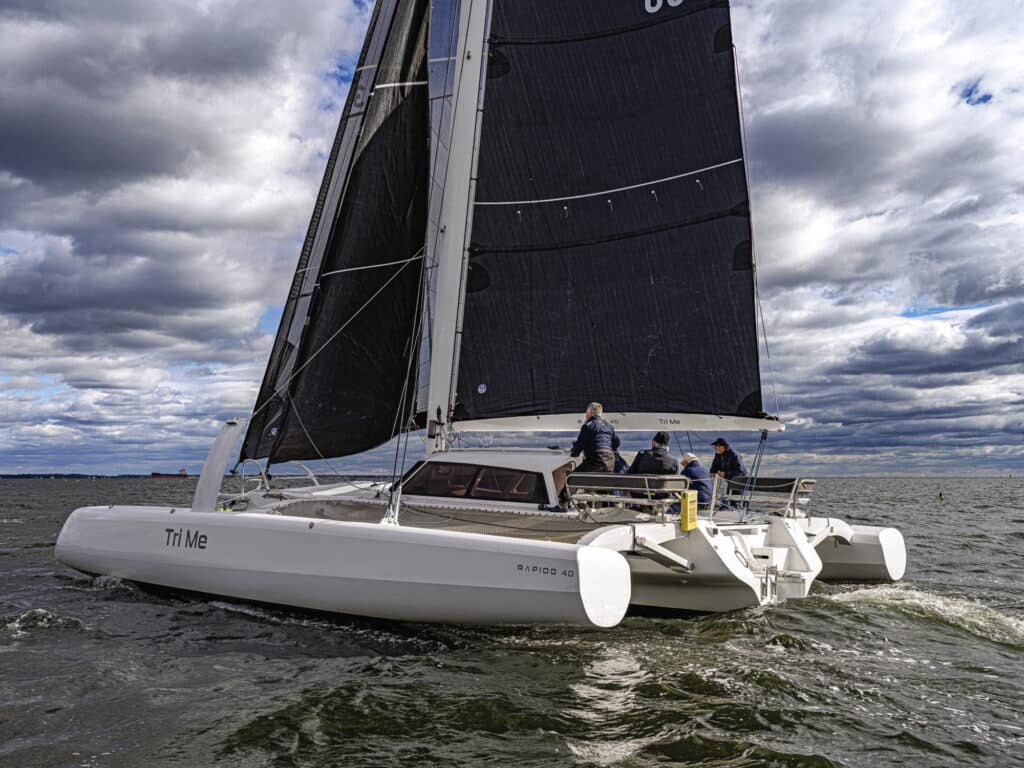
The design brief for the Rapido 40 is straightforward: fast cruising and racing for a couple or crew; ocean-ready but able to sail and moor in shallow water. Nobody was more psyched to sail the boat than judge Herb McCormick, who was not disappointed.
“I was first exposed to the brand at a multihull regatta in the Caribbean, where a larger Rapido 50 was in attendance,” he said. “I was on another boat, and we spent a lot of time looking at the Rapido’s transom. Then I stepped aboard the Rapido 40 for our trials and was handed the tiller extension; under the code zero, in about 15 seconds, we were making 14 knots. Whoa!”
Judge Mark Pillsbury said: “From stem to stern, the Rapido 40 came packed with features, including a double-taper carbon rotating mast, a Park Avenue-style boom for easy sail handling, daggerboards for upwind performance, and a very comfy cockpit. There’s an optional all-carbon version of the boat, including the drawers in the galley. The layout, with a comfortable V-berth and raised table in the salon—offering outstanding views of the great outdoors—is cruising-couple friendly.”
Judge Tim Murphy added: “The Rapido 40 is built in Vietnam by Paul Koch, the previous owner of Corsair Marine who started Rapido Trimarans in 2014. Rapido builds three models, all designed by the renowned team of Morrelli & Melvin. Our test boat had the standard infused construction, which is mostly E-glass with vinylester resin and a PVC core. There’s also carbon fiber near the bulkheads where the crossbeams meet. Carbon-fiber C-foils in the amas are intriguing and provide lift in two directions: up (to reduce sailing displacement but not fly) and to windward. Sailing the boat on the raised web seat with the tiller extension is gorgeous. It feels very sporty. Rapido’s latest claim to fame: The YouTube channel Sailing La Vagabonde has taken delivery of a Rapido 60, which will definitely raise the profile of the brand.”
- More: 2024 Boat of the Year , multihull , Print January 2024 , Sailboats
- More Sailboats

Sailboat Preview: Elan GT6 Explorer

For Sale: 1984 Camper & Nicholsons 58

Alubat Updates OVNI Models

For Sale: Little Harbor 63 Ketch

From Paradise to Medical Emergency: A Bahamas Nightmare Turns Lesson Learned

Free Medical Advice: The Unwarranted, Unprofessional Edition

Gatekeepers of the Waterway

Rigging Redo: Our Switch to Synthetic
- Digital Edition
- Customer Service
- Privacy Policy
- Terms of Use
- Email Newsletters
- Cruising World
- Sailing World
- Salt Water Sportsman
- Sport Fishing
- Wakeboarding
Advertisement
Environment
World's largest sailing cargo ship makes first transatlantic voyage.
The largest sailing cargo ship in existence is on its maiden voyage across the Atlantic Ocean, demonstrating a carbon footprint 10 times smaller than that of a container ship
By Jeremy Hsu
29 August 2024

The cargo sailing ship Anemos is crossing the Atlantic Ocean
Ronan Gladu/TOWT
The world’s largest sailing cargo ship is making its maiden voyage across the Atlantic Ocean. It left a port in France in early August, and it is on track to deliver 1000 tonnes of cognac and champagne to New York City by 3 September. Its shipments have a carbon footprint one tenth that of a standard container ship.
“For centuries we knew wind was abundant [over] the deep sea, and we had the pilot charts,” says Guillaume Le Grand , CEO of TOWT, the French company that commissioned…
Sign up to our weekly newsletter
Receive a weekly dose of discovery in your inbox! We'll also keep you up to date with New Scientist events and special offers.
To continue reading, subscribe today with our introductory offers
No commitment, cancel anytime*
Offer ends 10 September 2024.
*Cancel anytime within 14 days of payment to receive a refund on unserved issues.
Inclusive of applicable taxes (VAT)
Existing subscribers
More from New Scientist
Explore the latest news, articles and features

A simple driving trick could make a big dent in cars' carbon emissions

Amazon soil may store billions more tonnes of carbon than once thought
Subscriber-only

Millions of trees could grow faster with a boost from wild fungi

Can solar panels designed for space boost clean energy on Earth?
Popular articles.
Trending New Scientist articles
| The secure parts of this site use certificates from InCommon, which should be trusted by your web browser. If you have problems, please contact the . |
- Rules & Regulations
- Reserve the Pavilion
- .
- Sailing Cards
- Racing Cards
- Swimming Requirement
- New Account
- Mid-Week 1-2-3
- Sailing Booklet
- OpenCourseWare
- Skipper Rating
- Current Skippers
- Lynx Catboat
- Windsurfing
- Moon Light Sailing
- Harbor Trips
- Learn to Race
- Team Racing
- Firefly Fleet Racing
- Racing Results
- Hall of Fame
- Constitution
- Meeting Minutes
- Hatch Brown Service Award
- Sailing Team
- Learn-to-Sail
- Associations
Trimaran Sailing Boston Harbor, not an MIT sanctioned event
| Mon 02-Sep-2024 | 11:00-16:00 |
| Registration Start: | 29-August-2024 at 00:00 |
| Registration End: | 02-September-2024 at midnight |
Description
This is an opportunity for up to four people to sail with me on my 32' Farrier F32 trimaran. We would need at least two sailors who have experience with boats over 25'. We leave from the Boston Harbor Yacht Club and return there. The Yacht Club is a large gray building on the water, address 1805 Columbia Road, South Boston. Parking is not an issue nor is bicycle parking. . I would suggest that people bring something to eat and drink, a windbreaker, and whatever else you might want to be comfortable on a sailboat for several hours. If you are interested, please get back to me via email include a brief descripton of your sailing experience a number at which you can be reached by phone or text. Thank you,
https://f-boat.com/f-32/
Questions about this event should be directed to the organizer(s): Rob TAGIURI
Ainslie set to begin bid for America's Cup glory
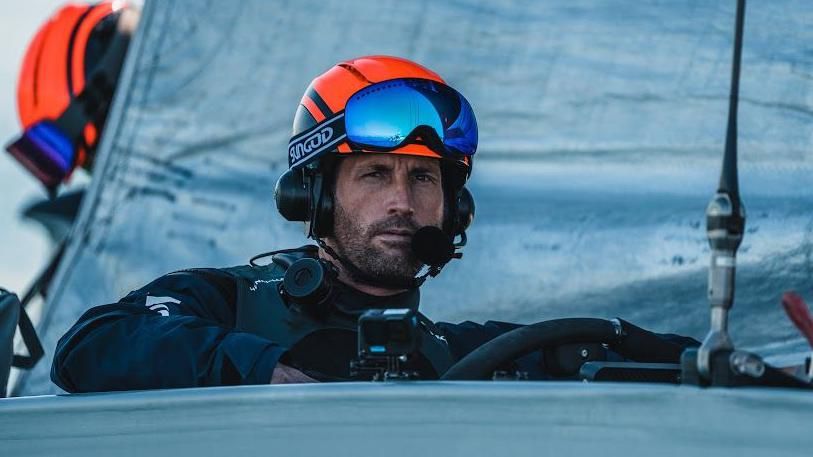
Ben Ainslie is at helm of the British America's Cup contender for the third time
- Published 21 August 2024
Ben Ainslie's Ineos Britannia team are set to start their bid to become the first British crew to win the America's Cup.
After almost three years of meticulous planning and testing, six teams will race their new AC75 boats against each other for the first time on Thursday in the final preliminary regatta.
The four-day event takes place within sight of the port area of Barcelona, the host city for the 37th America's Cup. , external
The competition begins in earnest on 29 August, with a series of races to decide which boat will take on defending champions New Zealand for the trophy in October.
Four-time Olympic sailing champion Ainslie is the skipper and chief executive officer of the Britannia team, , external which is backed by billionaire Sir Jim Ratcliffe's Ineos Group.
They have worked with the Mercedes Formula 1 team to develop their boat, and with the Ineos Grenadiers cycling team to help the crew reach their physical peak.
First held around the Isle of Wight in 1851, the America's Cup is the world's oldest sporting event.
Here is our guide to the 37th edition, which includes a women's series for the first time in the competition's 173-year history.
How does the America's Cup work and what's the schedule?
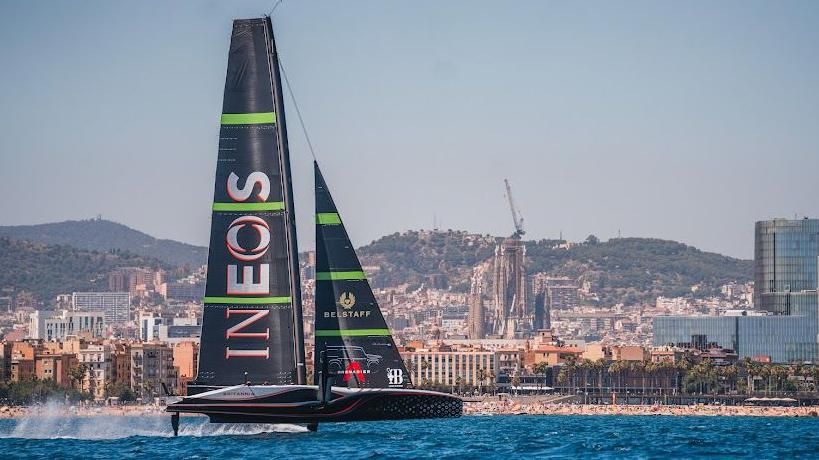
Ineos Britannia skimming over the water off the coast of Barcelona
Team New Zealand automatically qualify for the America's Cup final match having won the trophy - known as the Auld Mug - in 2021.
The British team will take on rivals from Switzerland (Alinghi Red Bull Racing), Italy (Luna Rossa), the United States (NYYC American Magic) and France (Orient Express Racing Team) in the Challenger Selection Series leading up to the final series.
Known as the Louis Vuitton Cup, there are three competitions from 29 August to 7 October:
29 August to 8 September: Louis Vuitton Cup round-robin stage - all teams race each other twice, with the top four going through and the leading team choosing who they face in the semi-finals
14-19 September: Louis Vuitton Cup semi-finals - first to win five races advances
26 September to 7 October: Louis Vuitton Cup final - first to win seven races qualifies for the America's Cup match
12-17 October: the 37th America's Cup - the Louis Vuitton Cup winner takes on holders Team New Zealand, with the first to seven race victories winning the trophy
• Races start at 13:00 BST and reserve dates are scheduled if required. You can watch the action live on TNT Sports.
How fast are the America's Cup boats?
Ineos Britannia have enlisted the help of engineering experts at the Mercedes Formula 1 team in Brackley, Northamptonshire in a bid to find a technical advantage over their rivals.
The AC75, or America's Cup 75, is a 75ft foiling race boat with one carbon-fibre hull (a monohull instead of catamaran or trimaran) and has been described as like a "large windsurfing board with towering sails" by Sailing World. , external
The AC75s - which have sails up to 26.5m high - have extendable hydrofoil wings which can lift the hull up and enable the boats to skim the surface of the water so they appear like they are flying.
This helps the boats to reach exhilarating speeds of more than 50 knots (57.5mph), despite weighing about 6.5 tonnes.
But make a mistake and the boats could capsize.
What is a cyclor and why are they key?

Britannia's crew features Olympic medallists and world champions from the sports of sailing and rowing
Fast starts are key, race tactics and weather conditions will all play their part, but it could be human effort which determines who wins the America's Cup.
Each boat has eight crew members, reduced from 11 last time, with two helmsmen and two sail trimmers on different sides.
Joining Ainslie as co-helm will be Olympic gold medallist Dylan Fletcher, who won the 49er class at Tokyo 2020, while Leigh McMillan and Bleddyn Mon are the trimmers.
The other four sailors on the boat provide the hydraulic power to trim the sails by pedalling static bikes fixed inside the hull.
Four of the nine "cycling sailors" in the Britannia squad have an Olympic rowing background - including 2016 gold medallist Matt Gotrel and Tokyo silver medallist Harry Leask.
Known as "cyclors", they have been put through their paces on dry land by Grenadiers’ top cyclists to build their endurance levels.
Double Olympic gold medallist Giles Scott is the team's head of sailing.
There is also a big onshore team including sailmakers, engineers, software technicians and even meteorologists.
It is estimated that the average America’s Cup campaign costs about £100m.
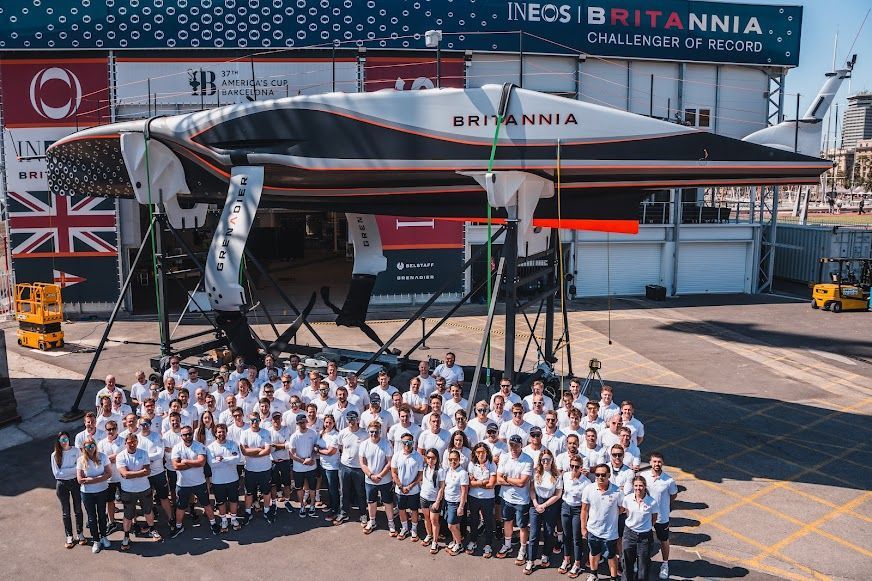
Ineos Britannia's performance, operation and support team in Barcelona with the AC75 boat Britannia
Ben Ainslie's mission to win the America's Cup
Ainslie won medals at five consecutive Olympics from 1996 onwards, including gold at four consecutive Games from 2000 to 2012.
Competing initially in the Laser category, he switched to the larger Finn boats and won nine World Championship titles across both classes.
Since winning gold at London 2012, Ainslie's goal has been to claim the America's Cup for Great Britain.
He set up his own British team to compete in the America's Cup World Series in 2012-2013 with the aim of gaining experience for a full challenge in 2017.
Ainslie went on to win the Auld Mug in 2013, using all his tactical nous to turn around Team Oracle USA's fortunes in spectacular style.
His two subsequent attempts in a British boat have ended in disappointment.
In 2017, Ainslie's Land Rover BAR team were knocked out in the semi-finals.
In the Covid-hit 2021 campaign, his Ineos Team UK won the round-robin stage but lost 7-1 to Luna Rossa in the final selection race series.
What about the Women's America's Cup?
Women have competed in the America's Cup before - most notably American Dawn Riley, who has sailed in the competition three times and was team manager of the French entry in 2007 - but have never had a standalone series.
The inaugural Women’s America’s Cup takes place in AC40 boats - a smaller version of the AC75 - from 5-13 October in Barcelona.
Great Britain's Athena Pathway will be one of 12 teams to start the qualification series from 5-9 October.
Hannah Mills, Britain's most successful female Olympic sailor - with two golds and a silver - leads the 12-strong British squad.
The 36-year-old from Wales has assembled a team full of Olympic and world medallists, including her former partner Saskia Clark and Paris 2024 kite sailing gold medallist Ellie Aldridge.
They will hope to advance to the final on 11 October, and from there reach the match race final on 13 October.
Great Britain are also represented in the Youth America’s Cup, taking place from 17-26 September.
Related Topics

COMMENTS
Sunrays, the 85-metre 2010 Oceanco, has an internal volume of 2,867GT. Solandge, the 85-metre Lurssen from 2013, has a gross tonnage of 2,899. The 90-metre DAR from Oceanco has an interior measured at 2,999GT, so only a snip more than 84-metre White Rabbit. All this volume is generated by the trimaran's 20-metre beam, which makes it around ...
The 84 metre White Rabbit was launched in 2018, becoming the world's largest trimaran. The multihull superyacht is the fifth in a series of White Rabbits and follows two Feadship monohulls, a 36-metre catamaran built by Austal and a 61-metre trimaran built by North West Bay Ships. The owners loved their 61-metre White Rabbit but were looking ...
The Biggest Cruising Sailing Trimaran in the World. The world premier presentation of a giant trimaran, a project by Monegasque company UltraLuxum, was recently done at Monaco Yacht Show (21 to 24 September 2011). Constructed in carbon fiber and fitted with retractable floats, the UltraLuxum CXL harnesses the very best of 21st-century technology.
USA-17—a 90-foot-long (27 m) trimaran, type BOR90. A traditional paraw double-outrigger sailboat from the Philippines. A trimaran (or double-outrigger) is a multihull boat that comprises a main hull and two smaller outrigger hulls (or "floats") which are attached to the main hull with lateral beams. Most modern trimarans are sailing yachts designed for recreation or racing; others are ...
Trimarans such as 84m/275.6ft luxury yacht WHITE RABBIT are a rarity within the luxury yachting industry, however the benefits of multiple hulls have been well recorded, providing greater stability and with top quality contemporary naval architecture, a smoother cruising experience with reduced noise and less of an environmental impact.
Cruising World Judges named the Neel 47 trimaran the Best Full-Size Multihull for 2020. In the large multihull class, at least for 2020, the Neel 47 proved that three hulls are better than two. The Eagle Class 53 was easily the most unique boat in the long history of Boat of the Year. Jon Whittle. It's hard to imagine three vessels, in a ...
Measuring 42.06m, the Prout 138'is the world largest sailing trimaran and the first sailing trimaran super yacht intended for luxury global cruising. The Prout PT-138-02 was infused in early March and construction on both of the world largest sailing trimaran yachts continues.
Performance Under Sail. Above: A 2023 NEEL 43 Trimaran Sailing Yacht underway. Photo by Olivier Blanchet / NEEL-Trimarans. We tested the NEEL 43 on the relatively flat waters of Chesapeake Bay in a healthy breeze of 18 to 22 knots. We found the key to powering up this model was the North Sails reacher on its top/down Facnor furler.
The Prout Trimaran 138' is designed and constructed as an all-composite shallow draft sailing trimaran with a 46 ft beam with a very small draft of only 1.52 m. The hull and deck are to be constructed utilizing Prout International's mold and when the Prout PT 138 is launched it will be the largest sailing trimaran in the world.
Trimaran sail trim. One of the biggest differences between a cruising monohull and a multihull is how the mainsail is trimmed. Leech tension on a yacht is often largely controlled by the kicker and the backstay, while the mainsheet sheets the mainsail in and out, predominantly controlling the angle of the boom to the centreline, and there may be a short traveller.
The list of the top ten largest sailing yachts in the world is not easily disrupted. In fact, it had remained unchanged since the launch of the 106.7-metre Oceanco Black Pearl in 2018, which swiped the top spot from Lürssen's 93-metre Eos.For four years, Black Pearl remained the largest yacht in the world until early in 2023 when Oceanco sent a new flagship down the slipway, the mighty 127 ...
Hemisphere is the largest sailing catamaran (two hulls) and the largest sailing private yacht catamaran in the world since 2011. [1] [2] She is 145 feet (44 m) long and built by boat builder Pendennis (UK).The vessel has won five different industry awards, including for the interior finishing. [1] In suitable weather, Hemisphere goes 13 knots (24 km/h; 15 mph), [3] with a top sailing speed of ...
(largest trimaran) 40.00 m (131 ft) 23.00 m (75 ft) 5.8 m (19 ft) 25 t: 720m² Full list. Yacht LOA Shipyard Designer Year Notes A: 142.81 m (469 ft) ... list of large sailing yachts, Boat International Media; list of large sailing yachts, Superyacht Times; list of large sailing yachts, Synfo
Designer, builder and sailing legend with his Black Marlin and Barracuda trimaran. The most successful sailracing boats on the Baltic Sea in the last decade. Jan is the multiple winner and record holder of the line honours (first ship home) at the World's largest single-handed race (Silverrudder, 450 competitors).
One of the biggest names in the game, ... Perfect for bringing the whole family out for a day on the water, this high performance, trailerable sailing trimaran strikes the most luxurious balance between quicksilver speeds and a smooth, comfortable ride. The Radikal 26 trimaran is as convenient to transport and set up as it is pleasant to sail ...
MACIF, a 98ft VPLP-designed trimaran built for 2012-13 Vendée Globe winner Francois Gabart, is the very latest Ultime, launched last summer. Since then MACIF was has won the Transat Jacques Vabre, the Transat bakerly and recently demolished the singlehanded 24-hour record, increasing it from 718.5 miles to 783.46.
This trimaran retails for $595,000, making it a cheaper option than the Rapido 60. 5. Dragonfly 40. The Dragonfly 40 measures 40 feet (12 meters) in length. It features high-comfort standards, making it one of the best trimarans in the market for taking your family for a cruise.
The 2019 Weta trimaran is easy to sail and is worth considering whether you want to take a quiet sail, race with your friends, or take kids to a sailing lesson. ... The largest trailerable trimaran is the Corsair 37, this multihull is built for single-handed cruising while still maintaining the ability to comfortably seat 6 people.
Runner-up: Rapido Trimarans 40. The Rapido 40 is a high tech, all-carbon, performance cruiser with a self-tacking jib, carbon spreaderless mast and an option for a roller furling boom. Walter Cooper. The design brief for the Rapido 40 is straightforward: fast cruising and racing for a couple or crew; ocean-ready but able to sail and moor in ...
NEEL sailing trimarans changed that up a few years ago by introducing a significant amount of living space across a larger main hull and wider amas capable of accommodating full-sized cabins. The powertri has adopted this design and it offers an astounding amount of room. Above: The salon onboard the 2022 LEEM 56 TRIMARAN.
Find your perfect trimaran sailing vessels. Trimaran yachts are large, sailing vessels frequently used for time-honored boating pursuits. ... Trimaran sailing vessels for sale on YachtWorld are offered at an assortment of prices from $24,471 on the relatively more affordable end all the way up to $1,561,917 for the most luxurious model vessels.
The world's largest luxury charter catamaran, HEMISPHERE boasts the ultimate fusion of extravagance and dynamic performance. This stunning 44.2m (145') sailing yacht commands unrivalled presence whether sailing or at anchor. HEMISPHERE will be available for charter in the stunning destinations of the Grenadines and Costa Rica until May 2024 and ...
A mega catamaran is defined by any multihull measuring over 100 feet in length, available in semi-custom and custom designs. These vessels can reach top speeds of up to 40 knots. ... World's Largest Sailing Cats 1. Sunreef MM 460 CAT - 150 Feet (Under construction) 2. Hemisphere (Pendennis) - 145 Feet 3. Douce France (Alu) - 138 Feet 4. Sunreef ...
The world's largest sailing cargo ship is making its maiden voyage across the Atlantic Ocean. It left a port in France in early August, and it is on track to deliver 1000 tonnes of cognac and ...
The company has since launched 50 boats built in South Africa—large, luxury bluewater cats—and now they've expanded into power cats as well. ... For more multihull reviews and stories, subscribe for ... Multihulls Sailing sailboats. By. Zuzana Prochazka. SAIL Charter Editor Zuzana Prochazka is a USCG 100-ton master who logs countless ...
This is an opportunity for up to four people to sail with me on my 32' Farrier F32 trimaran. We would need at least two sailors who have experience with boats over 25'. We leave from the Boston Harbor Yacht Club and return there. The Yacht Club is a large gray building on the water, address 1805 Columbia Road, South Boston.
The AC75, or America's Cup 75, is a 75ft foiling race boat with one carbon-fibre hull (a monohull instead of catamaran or trimaran) and has been described as like a "large windsurfing board with ...